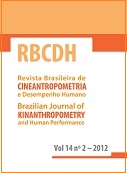Adiposity patterns in children and adolescents from Mozambique: a quantitative genetic study
DOI:
https://doi.org/10.1590/1980-0037.2012v14n2p164Abstract
The aim was to estimate the contribution of genetic factors in the skinfold (SF) patterning of children and adolescents from Mozambique. Six SF were measured, and seven phenotypes were derived: ?6SF, ?SF from the trunk, ?SF from the extremities, the ?SF trunk/extremities ratio (TER), first, second and third principal components. Heritability (h2) and correlations (r) in sibships were calculated using the ASSOC and FCOR modules of the SAGE 5.3 Genetic Epidemiology software. The h2 was high for TER (65%) and the third principal component (50%); moderate for ?6SF (48%), ?SF from the extremities (45%), ?SF from the trunk (42%), and the second and third principal components (39% and 33% respectively).Overall, r-values were moderate in same-gender sibships (0.21 to 0.44), and low in sibships of different gender (-0.02 to 0.18). In conclusion, genetic factors explain 33 to 65% of the total variance in different SF patterning phenotypes. Same-gender siblings showed greater familial aggregation in fat patterning than did opposite-gender siblings.



